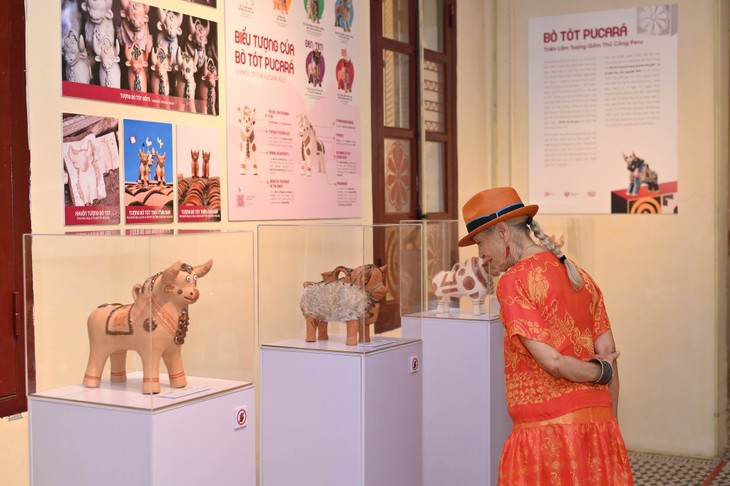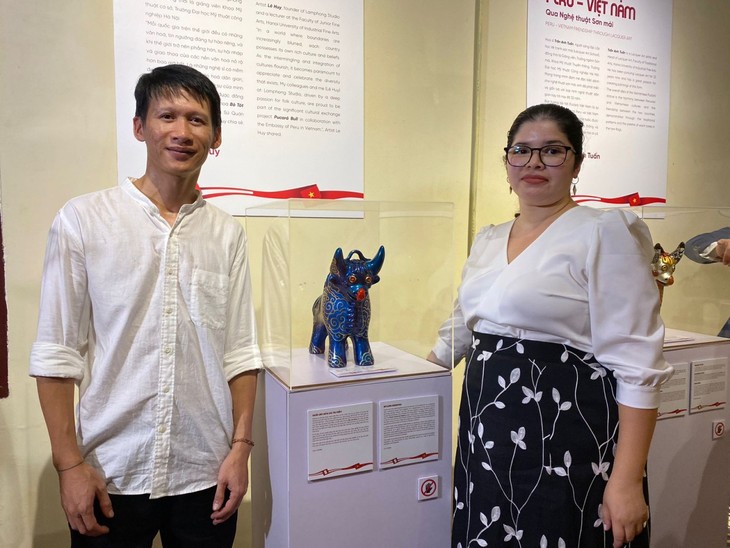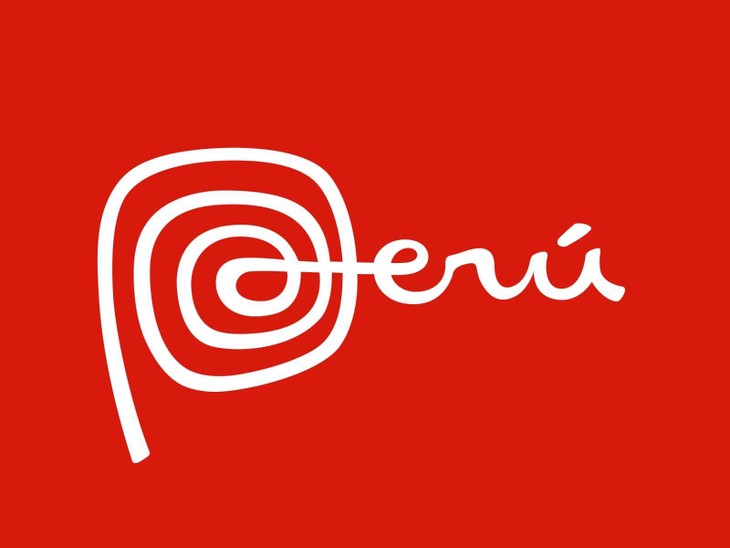 At an exhibition in Hanoi displaying 18 handmade ceramic Pucara bull statues (Photo credit: the Embassy of Peru in Vietnam) At an exhibition in Hanoi displaying 18 handmade ceramic Pucara bull statues (Photo credit: the Embassy of Peru in Vietnam) |
“Torito” means “little bull”. "Toritos de Pucará are little ceramic bulls created by the artisans of Checca Pupuja pottery village in Azangaro province, Peru.
Their history dates back to the arrival of the Spanish in America, when bulls began to be part of traditional festivals in the area.
Today, it’s common to find these items in Peruvian houses, ornamenting the roof or some other part of the house. Some people have them because of their bright colors and others because of the ancient symbolism of their design, according to Kristell Áviles Flores, the Deputy Head of Mission of the Embassy of Peru in Vietnam.
“The Pucará bull for us represents, first, a lucky charm. We believe that if you put one in your house, it’ll bring happiness for your family. But it also represents our identity as Peruvians. We are native Peruvians, but we are also Spanish descendants,” Ms. Flores explained.
A torito’s details carry many meanings. For example, the hole at the top of the sacrum represents fertility and the handle represents the marriage union of men and women.
The bull’s eyes stand for the alertness of humans in a sometimes-hostile world, as well as self-observation. Spiral forms painted on the bulls represent the spiral of life and the belief that everything one gives will be returned.
 The exhibition takes place at the Arts and Culture Center at 22 Hang Buom Street, Hanoi (Photo credit: the Embassy of Peru in Vietnam) The exhibition takes place at the Arts and Culture Center at 22 Hang Buom Street, Hanoi (Photo credit: the Embassy of Peru in Vietnam) |
According to Ms. Flores, at first, these bulls were something different and then they developed into a bull.
“We treat them like lucky charms. In ancient times, they represented more than that because the ancient Peruvians believed in many gods. Everything you paint on the bull represents an element of the earth, because Peruvians believe that the elements of the earth were gods,” the diplomat said, adding, “We normally use the form of the torito and paint on it the colors we like. Every color has a different meaning. If you want to prosper, you paint the torito green, for example.”
Placing two bulls together represents the fusion of positive and negative energies to achieve equilibrium and reach a common goal. It’s common to find pairs of bulls on the roofs of houses, as a symbol of protection and happiness for the families.
 In Andean culture, toritos typically appear in pairs, portraying the harmonious blend of positive and negative energy. (Photo credit: the Embassy of Peru in Vietnam) In Andean culture, toritos typically appear in pairs, portraying the harmonious blend of positive and negative energy. (Photo credit: the Embassy of Peru in Vietnam) |
The colorful bulls were originally used as jugs or canteens but now have become items used for decoration and significance in rituals and celebrations.
The Peruvian Foreign Ministry recently launched a cultural promotion program entitled "Torito de Pucará: Ambassador of the Peruvian Highlands" to introduce the bull statues worldwide.
Under this program, handmade ceramic Pucará bull statues were exhibited in Hanoi last month, part of a series of activities to mark 29 years of diplomatic relations between Vietnam and Peru.
Ms. Flores said it’s important to be aware that Peru also has ceramics and artists who do ceramics.
“Vietnam is well known for ceramics, so this exhibition shows how Peru and Vietnam have certain similarities. We want the Vietnamese public to learn about Peru, especially about Puno where the Pucara bull comes from,” Ms. Flores noted.
 Artists Le Huy and Kristell Áviles Flores, Deputy Head of Mission of the Embassy of Peru in Vietnam (Photo credit: the Embassy of Peru in Vietnam) Artists Le Huy and Kristell Áviles Flores, Deputy Head of Mission of the Embassy of Peru in Vietnam (Photo credit: the Embassy of Peru in Vietnam) |
The highlight of the Hanoi exhibition was the presence of bull statues contributed by two Vietnamese artists Le Huy and Tran Anh Tuan. This is the first time the Vietnamese public has had the opportunity to see Peruvian ceramic works and emulations created by two Vietnamese artists.
Artist Le Huy told VOV that his co-worker and him created Pucara bull statues using traditional Vietnamese lacquer and stylized adaptations of the cloud and dragon patterns on the stone stairs of Kinh Thien Palace in the Thang Long Imperial Citadel, the motifs on Dong Son bronze drums, and the lotus images that appear in ancient art.
“Through these bulls, we wanted to introduce Vietnam’s land and people and convey the similarities between Vietnam and Peru,” said Huy.
After the exhibition, the Embassy of Peru in Vietnam deposited one of the Vietnamese bulls into a Peruvian National Collection called "Pucará Bulls Around the World".
The others, Huy said, will be kept on display as a symbol of the friendship between Peru and Vietnam within the framework of 29 years of diplomatic relations.
 The spiral form that the “P” has is referred to one of the graphic motives present in all the cultures born in Peru's land. (Photo credit: the Embassy of Peru in Vietnam) The spiral form that the “P” has is referred to one of the graphic motives present in all the cultures born in Peru's land. (Photo credit: the Embassy of Peru in Vietnam) |
“In creating the bull statues, we found that there are similarities between Vietnamese motifs and the ancient motifs of Peru. The most representative is the spiral shape of the cloud motif, which is quite similar to ancient Peruvian motifs. The spiral shape resembles a fingerprint, which symbolizes movement, connection, and development,” Huy told VOV.
Since last November, the Pucará bulls have traveled to Japan, Singapore, Thailand, and Indonesia. After Vietnam, they will continue their journey to India and South Korea.